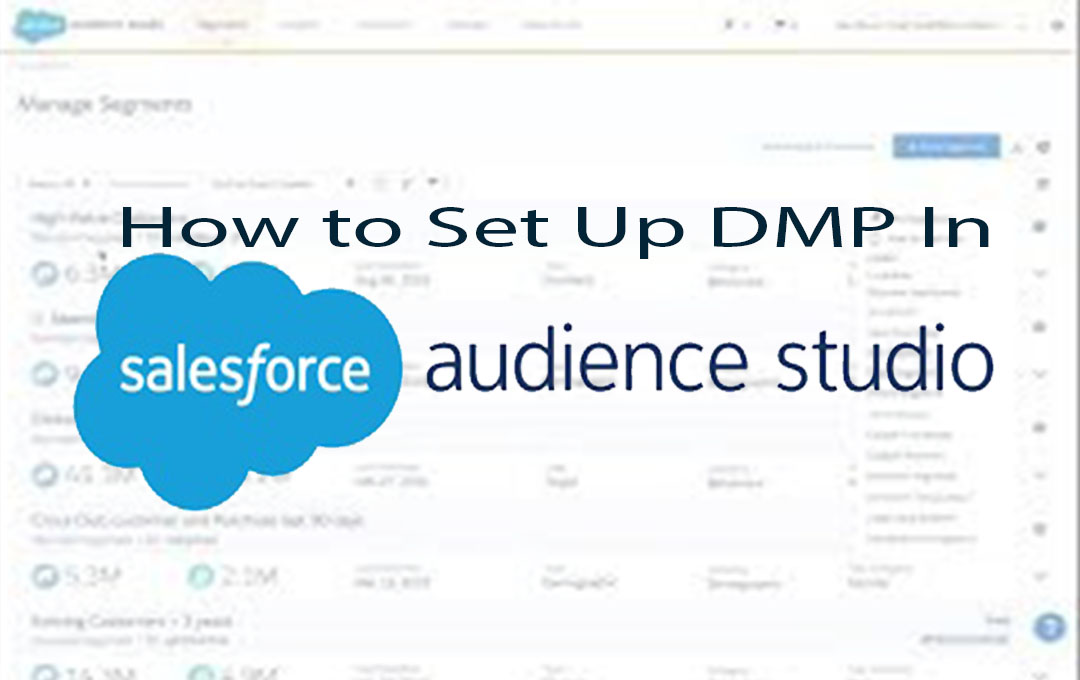How to Set Up DMP In Salesforce Audience Studio – Before Salesforce DMP, salesforce Audience studio supported data-driven marketing efforts. It accumulates, organizes, and activates all first, second, and third-party audience data from online, offline, mobile, and more.

To reach them effectively such platforms permit firms to attain unique insights into their customers.
How to Set Up DMP In Salesforce Audience Studio
This page will help you out on how to set up the DMP salesforce Audience studio. Moreover, they are four main elements in Audience Studio and they include Site (and their configuration tags, Attributes, segments, and Activations. It is imperative to take a closer look at the implementation and maintenance of those 4 parts to get most of the solution.
However, through this article, you will be able to understand how these elements relate to each other and what each solution brings, showing the path to follow for configuring Audience studio.
Configuration of Elements in Salesforce Audience Studio
These are the configuration of elements in the salesforce audience studio:
Site:
The Types of Sites that can be configured are:
- Gets information about impressions for media and clicks coming from media tools.
- Retrieve information from the digital environment of the business for websites or applications.
You will have to create a config ID when creating a site, the site’s identity. Regardless of the source, all data submission implementation must be configured to point to that identifier. Well, regarding website and application, the way to set triggers for Audience studio is to apply the control tag to a particular website in that environment.
For media follow-up, moreover, the implementation is specific to each vehicle and works by tagging campaigns, time of impressions, and clicks.
Attributes:
Information is sent with triggers that detail what data can be used in Audience Studio, which are the control tags of Attributes. However, you can titivate these attributes in an application on both android and IOS. Audience Studios must be implemented, and the track page view event will be sent with information about the page or user attributes.
Furthermore, to activate the website features to capture the page information the salesforce team must configure each control tag. Therefore, this requires a list sent for each site and can follow the format of a dictionary. After the list is sent, there should be a confirmation that the configuration is complete.
How do Attributes work?
If the site control tag is activated in the environments, the configured attribute must comply with the event pixel sent by the control tag. It should be available 24 hours after an attribute is first submitted, the Audience studio interface to manage certain attributes, such as category and display names.
More notably, to attribute popular display names it should be available. Must be active as well as deactivated. 24 hours after a feature is activated, when the number of users that triggered that attribute complies with the population limit rule. Hence, It should be available to be used as a rule in the segment and element of the tools.
Segments:
To activate users in other tools segments are user audiences that can be used. These are six (6) types of segments that can be built into the tool, each with specific feature and purposes:
- Standard – this help in aggregating users who meet the requirement of at least one rule and provides an accurate total population without duplication. Processing can be “on demand,” daily, weekly, or monthly.
- Real-time – As soon as the segment’s rules are met it adds users to a segment. Used for page retargeting.
- Composite – In a single event (same pageview) counts users who meet all rule requirements. This can be used to create an audience that engages with very specific content.
- Transactions – Counts users who buy a specific quantity at a specific price, on a specific date, Used for retargeting, deletion, or study on clients.
- Global Distribution – Uses data on impressions and clicks t create distribution frequency management for customers across channels and partners. In campaigns where the impact for some users is already saturated.
- Platform – To the segment by offline uploading to S3 of the business’s salesforce project it counts the users added. The segment is used in the upload via ID.
Yes, most clauses use attribute specifications, other clauses, or third-party data in their terms. However, by the logical operators AND, OR, AND NOT, clauses that use attributes or other class rules can be joined, and rules can be grouped into sets. The tool brings with it a wide range of segment creation possibilities.
Activation:
Activation, in the case of Audience Studio, involves sending information about the segment and its users to other tools so they can work with them. Hence, this Will tackle some of the ways to do this in the tool: send to the site, SuperTag, and send to partners:
Send to Site:
This send-to-site activation option allows fragment data to be returned to websites in their local storage and applications’ event callbacks. Activating a segment in “send to site” automatically change the frequency of updating the segment to “Daily”. Furthermore, in the toll interface, enabling or disabling this option when editing or creating segments is possible.
SuperTags:
In Audience studio, every time a user enters a segment or trigger all across the site. As well as whenever a user is assigned a certain attribute or is created for another type of rule. It is possible to activate one pixel and a few lines of JS code. SuperTag can be a solution to manage third-party tags, allowing a single tag on activation of the tags.
Partners:
Whose integration is already mapped by the connecting server (s2s) Audience studio has an extensive list of partners. Moreover, this involves Sending pixels with segment information, or any other connection.
Does Salesforce have a DMP?
The Salesforce DMP’s cloud-based data platform operates in real-time, unifying people’s data from all screens and sources into a single view. Nevertheless, If the individual analyzes the data to recognize each preference and activation that data across any delivery channel
How does Salesforce DMP work?
Well, A DMP collects, organizes, and activates first, second, and third-party audience data from any source online, offline, mobile, and more. These platforms allow your company to gain unique insights into your customers and effectively segment and reach your audience.
Check Out:
- How to Implement Subscriber Opt-In Using Salesforce Marketing Cloud
- How to Insert Data into Salesforce Marketing Cloud



